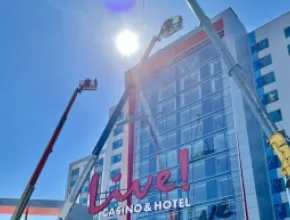While drive-to meetings may appear to be less complicated and more budget-friendly than those involving air travel, planners charged with these meetings say putting the brakes on expenses and ensuring that attendees get a smooth ride are not simple matters. Everything from parking costs to venue choices and carpool options requires careful attention.
Parking Woes Prevention
Room rates are not the only hotel costs skyrocketing in many cities—so is parking. This was a hard lesson learned by Wanda Jewell, executive director of the Southern Independent Booksellers Association (SIBA) in Columbia, S.C., who plans meetings and trade shows for members in 11 states, the majority of whom drive to the destination. At a recent trade show in New Orleans, Jewell was dismayed to find that attendees were faced with hotel parking charges of $40 or more per day.
“Parking is now on my radar in the way it wasn’t in the past,” she says. “Even though it’s still not as expensive in the South as it is in many places, parking is an area where more hotels and venues are looking to make money. I wished I had asked about it in New Orleans.”
While negotiating with hotels to reduce or provide complimentary parking is advised by planners, many are finding that it’s not always possible. A big obstacle is the fact that hotels and other venues often lease parking slots from outside companies.
“We always do our best to negotiate the parking costs, but a lot of hotels are telling us that they don’t own the parking lot and the prices are beyond their control,” says Laura Guerin, CMP, director of membership and events for the Southern Economic Council in Atlanta.
Because hotel valet parking is nearly always the most expensive option, providing a less-costly alternative is essential, according to Steve Parker, CMP, a veteran planner and vice president of communications for the South Florida MPI Chapter.
“Parking is much more of a cost issue than it was in the past, with valet parking easily costing $20 a day or more,” says Parker, who plans the monthly meetings for his MPI chapter. “So I always find nearby parking at a surface lot or some other alternative. Then, on the meetings registration page, we’ll list the alternatives to valet parking, along with the rates and directions to the lots.”
Similarly, Holly Stevenson, CMP, senior meeting planner for Cross Country Education in Brentwood, Tenn., says she always makes parking details a visible part of online meetings information as well as in any pre-conference e-mail communication to attendees.
Far from a small matter, addressing the parking situation is an important part of improving the meeting experience and keeping costs down for drive-to meeting attendees, who are likely to be regional association members paying their own way or on a tight budget.
“When you can provide free or reduced parking for your attendees, it shows that you are taking care of your people,” says Debbie Furman, CMP, senior meeting planner for the Texas Association of School Boards in Austin, Texas. “All of our school districts are run on public money, so our members have to be accountable. So any savings I can provide is a big help.” PageBreak
Destination Decision
Are there destinations or hotel choices that work best for drive-to meetings? As with any meeting, it comes down to understanding the needs and preferences of attendees.
For Dana Rhoden, principal and chief creative officer for the Dallas-based Veterinary Education Network, this means finding budget-friendly destinations that work for her attendees, who are paying their own way to attend seminars for continuing education credit, and who often bring family along.
“We design many of our meetings as specifically drive-to events,” she says. “For us, this means looking for easy access via highways, low- or no-cost parking, activities for family that are nearby or on-site, and for hotels that are pet-friendly and offer mini fridges, security, wireless Internet and breakfast included in the room rate.”
Choosing a destination that is within driving distance of a large population base is a consideration for Stevenson, who says her attendees are often paying their own way and prefer to drive.
“For example, we’re going to be in Nashville this year, which means that people from Atlanta will be able to drive there,” she says. “If you are near other metro hubs, it makes a difference.”
Determining the distance that makes a destination drivable for most attendees is not an easy matter, with planners putting anywhere between four and six hours as the tipping point. Convenient locations are a big issue for SIBA’s Jewell, who says most of her members will not attend unless they can drive to a meeting.
“We give away a lot of books at our show, so they want to be able to take them back in their cars,” she says. “Our members are spread out over 11 states, so we can’t please everyone every year. So we rotate the destinations so that every member is within driving distance—no more than six hours— at least every four years.” PageBreak
Diving in the Pool
Both cost-effective and environmentally friendly, carpooling is a good option for drive-to meetings, planners say. In making it work, however, planners need to take a pro-active role, according to MaryAnne Bobrow, CMP, president of Bobrow & Associates in Citrus Heights, Calif., who frequently plans regional association meetings.
“You can send out a message to attendees that if they want to carpool, you can match them up,” she says. “And ask for volunteers who are willing to drive. You can’t just make the suggestion but not help facilitate it.”
MPI’s Parker agrees, adding that LinkedIn and Facebook pages provide effective means for putting out the word about carpooling. Carpooling has proved to be a popular option for his MPI chapter meetings, with some participants viewing it as a way to network en route to the meeting.
“In many cases, suppliers will offer to drive planners to the meeting—they see it as a golden opportunity,” he says. “Or it provides bonding time for planners to share their experiences in the industry. And it reduces the carbon footprint, so it’s good all around.”
To cut down on drive time for members, Parker is planning a hybrid meeting for the South Florida MPI Chapter meeting in November that will enable members to choose between attending in Miami or Palm Beach.
“Our speaker will be in Miami in South Beach, but the presentation will be webcasted up to the Palm Beach Convention Center,” he says. “People in both locations will be able to interact with the speaker, asking questions in real-time.”
Day-Trippers
In some cases, drive-to meetings are short enough to require just an overnight or even no room nights at all. While simpler in some ways, booking few or no sleeping rooms means that getting affordable meeting space is more difficult, according to Bobrow.
“The hotels are not likely to comp your meeting space if they’re not getting a certain number of room nights,” she says. “Another problem is availability—if you are not committing to hotel rooms, the hotel is not likely to hold the meeting space for you.”
When planning day meetings, Bobrow seeks out venues that typically charge less for meeting space than hotels do, when sleeping rooms cannot be used for bargaining leverage.
“Community centers and even places like Elks or Lions clubs can work well as alternatives to hotels,” she says. “I’ve even done small trade shows at wineries.”
Maria Lenhart is a seasoned travel writer and frequent Meetings Focus contributor.







